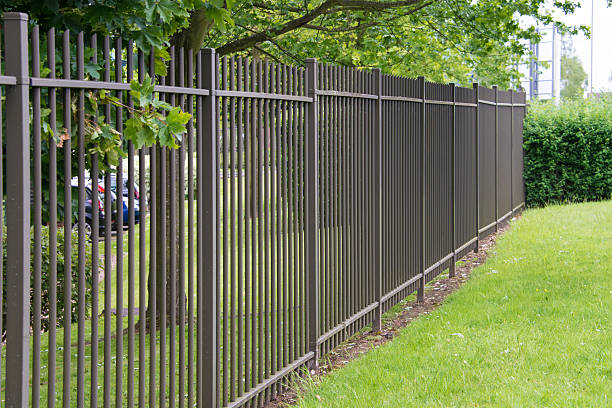Explores Aluminum Fence – Classic Style with Practical Benefits
Aluminum fences combine durability, low maintenance, and timeless design—making them perfect for enhancing both security and curb appeal. Unlike wood or iron, they resist rust, fading, and weather damage, while offering a sleek, modern look that fits any home or garden.

When planning to enhance your property’s boundaries, aluminum fencing stands out as a versatile solution that combines timeless elegance with modern functionality. Homeowners appreciate its ability to mimic the look of wrought iron without the heavy maintenance burden. Aluminum fences resist corrosion in humid climates, withstand temperature fluctuations, and maintain their appearance for decades with simple occasional cleaning. Whether you’re securing a backyard, defining garden spaces, or adding curb appeal, understanding the features and investment involved helps you make an informed decision.
What Influences Aluminum Fence Cost?
Several factors determine the overall investment in aluminum fencing for your property. Material quality plays a significant role, with commercial-grade aluminum panels typically costing more than residential-grade options due to thicker gauge construction. Height and style also impact pricing—ornamental designs with decorative finials or arched tops command higher prices than simple flat-top panels. Installation complexity matters as well; properties with sloped terrain or obstacles like trees and utility lines require additional labor and custom adjustments. Geographic location affects both material and labor costs, with urban areas generally seeing higher rates than rural regions. Finally, the total linear footage needed directly correlates with your budget, making accurate measurement essential during the planning phase.
Prices, rates, or cost estimates mentioned in this article are based on the latest available information but may change over time. Independent research is advised before making financial decisions.
Choosing the Right Residential Aluminum Fence
Selecting the appropriate aluminum fence for your home involves balancing aesthetic preferences with functional requirements. Residential aluminum fences come in various styles, from classic picket designs that complement traditional homes to contemporary horizontal slat patterns for modern architecture. Consider the primary purpose of your fence—privacy, security, decoration, or a combination. While aluminum doesn’t provide complete visual privacy like solid wood or vinyl, semi-privacy designs with closely spaced pickets offer partial screening. Gauge thickness matters for durability; residential applications typically use .050 to .080 gauge aluminum, with thicker options providing greater strength against impact. Color choices extend beyond basic black and white to include bronze, green, and custom powder-coated finishes that resist fading. Gate placement and hardware quality deserve attention, as these high-use components need robust construction to maintain smooth operation over years of use.
Understanding Aluminum Fence Panels and Installation
Aluminum fence panels are manufactured in standardized sections, typically ranging from 4 to 8 feet wide, which simplifies installation and replacement. These pre-assembled panels connect to posts anchored in concrete footings, creating a sturdy framework that distributes weight evenly. The modular nature of aluminum fence panels offers flexibility for navigating property lines with corners, slopes, and irregular boundaries. Most panels feature welded construction rather than screwed joints, enhancing structural integrity and reducing maintenance points where loosening might occur. Rack-ability is an important feature that allows panels to adjust to grade changes without custom cutting, making aluminum particularly suitable for hilly terrain. DIY installation is possible for homeowners with basic tools and construction knowledge, though professional installation ensures proper alignment, secure footings, and compliance with local building codes. When evaluating panels, examine connection systems—some use brackets while others employ rail-through-post designs that provide cleaner lines and enhanced strength.
Comparing Aluminum Fence Options and Costs
Understanding the range of products and their associated costs helps you budget effectively for your fencing project. The following comparison reflects typical market offerings from established manufacturers and suppliers.
| Product Type | Provider | Key Features | Cost Estimation |
|---|---|---|---|
| Standard Residential Panel | National Fence Suppliers | 4-6 ft height, .050 gauge, flat top | $25-$40 per linear foot |
| Ornamental Grade Panel | Premium Fence Co. | 4-6 ft height, .060 gauge, decorative finials | $35-$55 per linear foot |
| Commercial Grade Panel | Industrial Fence Systems | 6-8 ft height, .080 gauge, heavy-duty construction | $50-$75 per linear foot |
| Semi-Privacy Design | Specialty Fence Providers | Closely spaced pickets, .060 gauge | $40-$60 per linear foot |
| Custom Powder-Coated Panel | Custom Fence Solutions | Various heights, custom colors, .060 gauge | $45-$70 per linear foot |
Prices, rates, or cost estimates mentioned in this article are based on the latest available information but may change over time. Independent research is advised before making financial decisions.
These estimates typically include materials only. Professional installation adds approximately $10-$20 per linear foot depending on site conditions and regional labor rates. A complete residential fence project for a standard quarter-acre lot might range from $3,000 to $8,000, including materials and installation.
Maintenance and Longevity Benefits
One of aluminum fencing’s most appealing characteristics is its minimal maintenance requirement compared to alternative materials. Unlike wood, aluminum never needs staining, sealing, or painting to maintain structural integrity. Powder-coated finishes resist chipping and fading, typically maintaining their appearance for 15-20 years before showing significant wear. Routine maintenance involves occasional washing with mild soap and water to remove accumulated dirt, pollen, or environmental residue. Aluminum’s natural resistance to rust makes it ideal for coastal properties or regions with high humidity where iron would quickly deteriorate. Inspect gate hinges and latches annually, applying lubricant to moving parts to ensure smooth operation. If panels sustain damage from impacts or falling branches, individual sections can be replaced without dismantling the entire fence system. This modular repairability extends the overall lifespan of your investment, with quality aluminum fences regularly lasting 30-50 years with proper care.
Environmental and Practical Considerations
Aluminum fencing offers environmental advantages that appeal to eco-conscious homeowners. The material is highly recyclable, with most aluminum fence products containing significant recycled content. Manufacturing processes have become more energy-efficient, reducing the carbon footprint associated with production. Aluminum’s longevity means fewer replacements over time, decreasing long-term resource consumption compared to materials requiring more frequent renewal. From a practical standpoint, aluminum fences comply with most homeowner association regulations and local zoning requirements, though always verify specific restrictions in your area before purchasing. The material’s lightweight nature simplifies transportation and handling during installation while still providing adequate security for residential applications. Pool enclosures frequently utilize aluminum fencing because it meets safety codes, resists chlorine exposure, and allows visibility for supervision. Consider local services in your area for professional consultation on design options, permit requirements, and installation timelines that fit your project schedule and budget constraints.
Conclusion
Aluminum fencing represents a practical investment for homeowners seeking durable, attractive property boundaries with minimal ongoing maintenance. By understanding cost factors, panel options, and installation considerations, you can select a system that meets both aesthetic preferences and functional needs. The combination of classic styling, weather resistance, and long-term value makes aluminum an enduring choice for residential applications across diverse climates and architectural styles.



